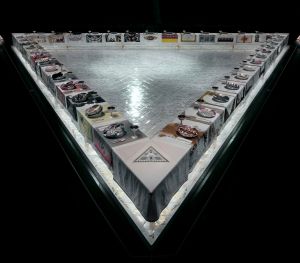When we discuss matters of reality and myth, science always seems to fall firmly in the category of ‘fact’. Add the word ‘fiction’ to the end of the phrase and suddenly you’re “in a world of pure imagination,” as Willy Wonka might posit.
Or are you? Today’s science fiction is a lot closer to tomorrow’s fact than you might think.
Ideas surrounding technology in the 21st century are often synonymous with larger than life innovators and divine ingenuity. The words “tech innovation” conjure images of researchers in a lab or maybe a Harvard dorm room, working with a singular mission to complete and an enigmatic problem to solve. While this may be an appealing Hollywood storyline, many of our culture’s most pertinent tech innovations came from people who – rather than working with a particular devotion to science fact – had the inspiration to create future worlds of science fiction.
This isn’t a new trend either; H.G. Wells’ science fiction novel War of the Worlds, published in 1898 went on to inspire Robert H. Goddard, the American inventor of the liquid-fueled rocket. More recent sci-fi inspired tech include the 3D interactive user interface used by Tom Cruise in Minority Report (2002), now present in most touch screens and motion-sensitive video games. Similarly, Stanley Kubrick may in fact be the true inventor of the now common tablet computer, which first appeared in the filmmaker’s 1968 film 2001: A Space Odyssey. Jeff Bezos, Amazon founder and self-proclaimed sci-fi fanatic, has also admitted that the Amazon Echo and its voice assistant Alexa were informed by Start Trek’s talking computer. Star Trek also lays claim to perhaps the most ubiquitous prediction of science fiction in today’s world: the cellphone. Martin Cooper, one of Motorola’s lead engineer in the 1970s at Motorola, has explained that Captain Kirk’s communicator was the original inspiration for his development of the world’s first handheld mobile phone.
Some of these developments, however, are also the result of a science fact-fiction feedback loop. For example, both Minority Report and 2001: A Space Odyssey had a team of industrial designers, futurists, engineers, and advertising specialists that consulted with directors Stephen Spielberg and Stanley Kubrick in order to try and build a fictional world that was as close to a future reality as possible. Spielberg explains that in the development process he consciously focused on mixing the old and the new: “I wanted all the toys and tech to come true someday. I want there to be a transportation system that doesn’t emit toxins into the atmosphere. And the newspaper that updates itself. At the same time, the city is not all skyscrapers with coils around them. In Washington, with its historical preservation rules, they’re never going to change some neighborhoods, or the Mall, the Jefferson Memorial and the Lincoln Memorial.”
Science fiction’s impact in shaping new technology can be recognized in the rise of design fiction. Where science fiction stimulates the imagination with extraordinary views of possibilities ahead, design fiction explores futures more accessible to ordinary people. In this context, design is used to provocatively envision our future technology and, by extension, our society. For instance, the DNA-structured society depicted in Gattaca (1997) predicted the experimentation with biometrics that many governments and labs are pursing today. On the flip side, the movie also presents a compelling warning regarding the potential extremes of medical technology. Designers themselves are also increasingly crossing the lines between real and fictional world building. Syd Mead, a 1959 graduate of the Art Center College of Design, is not only responsible for the design of many of Hollywood’s most influential sci-fi films including Blade Runner, Tron, Star Trek and Aliens, he has also designed cars for Ford and electronics for Philips.
But the influence of science fiction on science fact goes even further still, as scientists have begun to investigate the way futuristic fictions influence and predict the development of design and technologies.
Along these lines, Philipp Jordan and a team of scientists at the University of Hawai’i have been examining individuals involved in human-computer interaction and design research, studying the influence of science fiction in both the public academic sphere as well as the private research sphere. The team has found that science fiction is playing an increasingly influential role on the work these scientists are conducting. This influence can be seen in a variety of ways; theoretical design research, human-computer communication innovation, and human body modification are all undoubtedly shaped by science fiction books and films.
“Sci-fi movies, shows, or stories do provide an inspiration for the foremost and upcoming human-computer interaction challenges of our time, for example through the discussion of shape-changing interfaces, implantables or digital afterlife ethics,” say Jordan and co. Researchers today are also much more willing and much more likely to explicitly mention science fiction in publications, research proposals, project reports, etc. Jordan’s team also speculates “that the explicit referral of sci-fi in human-computer interaction research represents a fraction of the actual inspiration and it has had.”
Technology companies themselves are also actively blurring the lines of science and fantasy. Many companies and startups both employ and promote futurists who use science fiction (along with science fact) as a medium of understanding and prediction, to imagine what the world might look like 25 years from now. Adopting a “science fiction lens” allows companies to better plan their potential designs and marketing strategies, and brace themselves for the social impact of their creations. This kind of analysis is often called science fiction prototyping.
It appears that today, the bridge between science reality and fantasy is slowly eroding. The debate surrounding science fiction – or in design terms, design fiction – is a conversation that empowers individuals to look and think ahead; such a vantage point allows both professional futurists and amateur enthusiasts alike to predict future technologies, which may in turn shape policy and academia along the way.
So, next time you turn on a sci-fi movie, take the time to think about the tech - because the fiction in sci-fi may not be far from fact.




